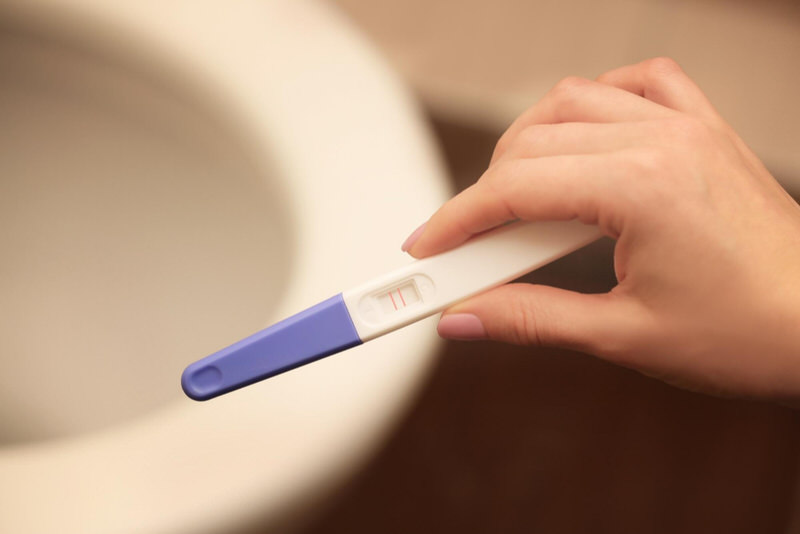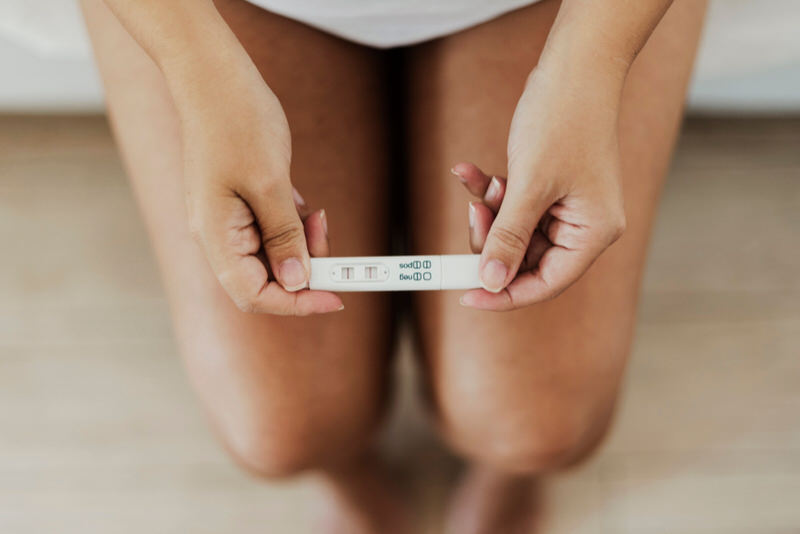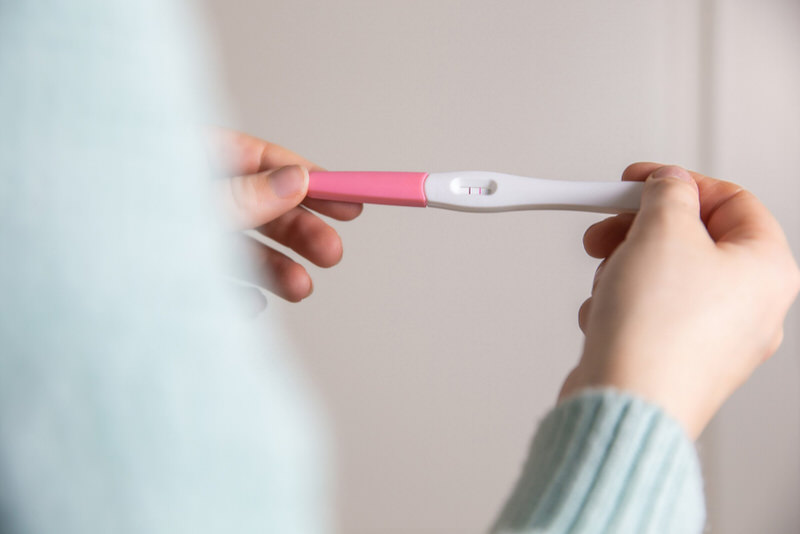Always go for the pink dye tests while buying home pregnancy tests. Both blue and pink dye pregnancy tests check the human chorionic gonadotropin (hCG) level in your urine. The problem with the blue dye tests is that they can give a faint evaporation line which can often be mistaken for a positive test.
As your urine evaporates, the test may show a faint grey-colored line, which resembles blue on the stick, and you might get a false positive. Both pink and blue dye tests are good to use, but if you’re in the very early stage of pregnancy, where the hCG count isn’t that high, a blue dye test may give you false results. So, better to buy a pink dye test, and the better part is pink dye tests are cheaper than blue dye tests.
Those 5 minutes in the bathroom can be both exhilarating and exhausting. While opening pregnancy tests, the number of emotions and feelings in your head and heart can be unbearable. A lot is riding on those two little lines on the stick.
Be it a first-timer, or a person who didn’t expect a pregnancy, or someone who struggled to become pregnant, all of these women, spend those nerve-wracking and the longest 5 minutes of their life in the bathroom, waiting for the test to tell you whether you’re pregnant or not.
There is nothing worse than a pregnancy test showing you a false ‘+’ positive when you’re not pregnant- talk about emotional letdowns and heartbreaks.
While opening the pregnancy test box, a whirlwind of questions like, are you pregnant? Will you pee all over your hand? What if you’re not pregnant? What will you tell your partner if you are pregnant? All of this will be swirling in your mind, and believe it or not, I’ve been in your position more often than I like.
But before you unwrap the pregnancy box, know which color dye test you should go for or whether digital pregnancy tests are better?
How does a pregnancy test work?

You might think, well, pregnancy tests are not rocket science. All you have to do is pee on a stick and see the results. Umm…is that all? I don’t think so. When you start doing the test, you’ll see it’s no less than an experiment.
A pregnancy test works by reacting to the hCG found in your urine. This hormone is produced almost 6 to 8 days after a fertilized egg has implanted itself in the uterine wall.
The longer you wait to test your pregnancy, the accurate the test will be, as the hCG levels double every few days if you’re pregnant.
When I did a home pregnancy test, the test came back neither negative nor positive. I used a pink dye test, and there was a single line and a second very *emphasis on the very* faint line.
I had no idea what to make of it. Was it a negative result? Is the stick faulty? But it turns out I checked too early in my pregnancy, which is why there was a very faint line, as the hCG level was present but still low.
There are a plethora of pregnancy tests brands available today in the market. Some pregnancy tests might be able to detect your pregnancy as early as 10 days after conception, but most doctors advise waiting until your next period to take a test. This way, you’ll get 99% accurate test results.
You’ll find various types of pregnancy test sticks. There are some you have to pee on, and there are cassettes with which you get a dropper and sticks that you have to dip into a cup of urine.
Dye pregnancy tests are more sensitive to hCG than digital pregnancy tests in your urine. According to internet popularity, pink dye tests are here to win, and you’ll know soon why.
Generally, most dye tests will only detect hCG in your urine at the level when it’s between 25 mIU/mL and 50 mIU/mL, and that is why most doctors will ask you to wait until your next period date. The most accurate pregnancy test results are yielded from blood work.
What makes a good pregnancy test?

For a pregnancy test to be user-friendly and good, it first needs to be easy to read. It should be easy for the person to understand whether the test result is positive or negative. If there’s a dark line along with a faint line, it isn’t evident for any woman anxiously waiting for the result.
The second thing needed is accuracy. False positives and false negatives both are disheartening. The test needs to be accurate and react to the hCG in the urine. But, if you check too early, you might not get a correct result and might get a false negative.
The third factor that makes a pregnancy test good is the sensitivity to the hCG present in the urine. Every brand has a numeric value of hCG by which it can detect the hCG level. Since this numeric value differs from brand to brand, you might get negative with one brand and positive with another.
Pink vs. blue – which pregnancy test is better?
Over-the-counter pregnancy tests are either dye-based or digital. As much as we would love to use a digital one that tells you whether you’re pregnant or not, in reality, the digital pregnancy tests have the least sensitivity to the hCG level in urine.
It’s only when the hCG levels have doubled and are increasing day by day, a digital pregnancy test will let you the accurate result; otherwise, the test result will be negative when in fact, you are pregnant.
The internet sides with a pink dye test when choosing between the pink or blue dye test. From my experience and what I’ve heard from many women, pink dye tests are less prone to evaporation lines. Blue dye tests are notorious for false-positive results, meaning you might see a “+” sign on your stick, but you may not be pregnant.
The blue dye test works by using an evaporation line that depends on the evaporation of the urine and which turns out to be a ‘colorless’ line. This colorless line is greyer, but it resembles the blue dye on the stick because of its shadow. And if you see, you might see a ‘+’ sign with a faint horizontal line, making you think you’re pregnant.
So, if you’re in the local supermarket, go for the pink dye test. There are a range of brands offering the pink dye pregnancy test, and believe it or not, and they’re cheaper than the blue dye pregnancy tests.
What are evaporation lines and false positives?
Most dye tests are accurate in their results, but you need to read the test correctly to know whether you’re pregnant or not.
Many dye tests are designed with 2 lines- a control line and a test line. A control line will always appear after the stick reacts with the urine, but the test line will only appear if the stick reacts with the hCG if present in the urine.
Unfortunately, sometimes, the evaporation of the urine used for the test will create a very faint second line in the test area. This happens when you see the result after the suggested wait period. Most dye tests will have a waiting period of 3-5 minutes. If you see the stick after 10 minutes, you might see a faint line in the test area, leading you to believe that you’re pregnant, when in fact, you may be not.
There was a faint second line in the test area, which only became darker after a long time had passed. I did believe I was pregnant and shared the news with my husband too, but it’s only after I realized that the faint line is sometimes an evaporation line. Fortunately for me, I was pregnant but took the test too early. This might not be the case for the others. You might not be pregnant, but the evaporation line may make you think that the result is positive.
False positives are not that common, like false negatives.
False positives might appear when:
- There’s an evaporation line, or..
- You have a chemical pregnancy, meaning the fertilized egg cannot attach to the uterine wall and grows. Most chemical pregnancies are not detected, and you may get your period even before you know you are pregnant.
- You have an ectopic pregnancy. This happens when a fertilized egg implants itself outside the uterus.
- There’s a loss of pregnancy. The presence of hCG remains in the blood and urine for weeks after you had a miscarriage or an abortion.
How to identify evaporation lines

You can identify whether the second line may be an evaporation line if:
- It’s been more than 10 minutes since taking the test.
- The color of the second line is colorless looking grey rather than having a hint of color to it.
- The second line may resemble a water spot and has no visible dye.
Note: If the control line on the test doesn’t change any color or doesn’t appear, it means that the test has failed.
How to prevent evaporation lines
- Read the instructions on the boxy and set a timer, accordingly, after the test stick comes in contact with your urine.
- Check whether the dye test is damaged or has expired.
- Take a pregnancy test first thing in the morning for the stick to react to the hCG level present in your urine.
- Take a more sensitive test, and wait till your next period to take a pregnancy test. This way, the result will be more accurate.
- Avoid over-hydrating yourself. You don’t need your urine to be too diluted. Wait for 2-3 hours to drink and then pee on the stick.
FAQs
Can you use a pink dye pregnancy test again?
No. pregnancy tests are use-and-throw tests, and you can use them only once.
Can I dip a pregnancy test in the toilet?
Dipping your pregnancy test in the toilet won’t give you an accurate result, as the urine will already be diluted with the toilet water. It’s best to either pee on the stick or pee in a cup and then dip the test in the cup for accurate results.
Should pregnancy tests get darker every day?
Yes, as the hCG present in your urine and blood doubles up every few days, the test line on the pregnancy test should also become darker.
Does a darker test line mean you’re carrying twins?
Suppose you’re taking a home pregnancy test a few days before your period, and you get an immediate response with a darker line. In that case, there’s a possibility that you’re carrying twins as hCG levels in your body doubles up if you’re carrying multiples.
Takeaway
In the end, the choice is yours whether you want to take a pink or blue dye pregnancy test. In my opinion, if you think it’s still early to take a test, then buy a pink dye test as it’ll be more accurate, and the chances of an evaporation line decrease.
If you’re still unsure about the results you got, you can check in with your OB/GYN and get blood work done to know your hCG levels.


